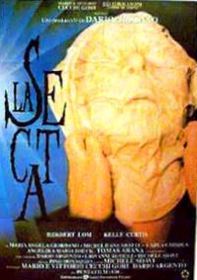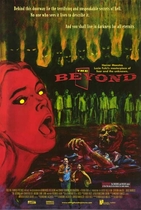Our editor-in-chief Nate Yapp is proud to have contributed to the new book Hidden Horror: A Celebration of 101 Underrated and Overlooked Fright Flicks, edited by Aaron Christensen. Another contributors include Anthony Timpone, B.J. Colangelo, Dave Alexander, Classic-Horror.com's own Robert C. Ring and John W. Bowen. Pick up a copy today from Amazon.com!
The Sect (1991)
When I first sat down to write my review of The Sect, I was surprised that the vivid images in my mind seemed to be fleeting. But then I realized how appropriate this is, since like almost all films that Dario Argento has a hand in, The Sect is nothing if not an extended, dark dream.
Although not officially directed by Argento (here he serves as producer and scriptwriter instead), The Sect, more than any other of director Michele Soavi's films that I've seen to date, strongly bears his directorial influence. However, I like this film better than any other work I've seen of either artist-perhaps collaboration suits them best, as they seem to both keep each other's runaway, tangential qualities in check, retaining a tighter focus and ensuring that all the elements that comprise a solid film are present.
Argento's films can sometimes seem dreamlike in a negative way-that is, they occasionally leave all semblance of story on the sidelines, in fact forgoing everything but strong visual design. The Sect keeps all the visual brilliance (just check out the color transitions in the title sequence as we pan across a desert lake or the set/production design of our heroine's basement) but caps it with a wonderful, surreal plot that is as deeply engaging as nightmarish.
The prologue would have made a fine film in itself. Soavi sets us in a California desert in the early 70's. A caravan of hippies with a stroke of bad luck is picnicking there when they encounter Rolling Stones-quoting Satanic bikers. Near the end of the scene, we see the leader of the gang walk up to a limousine and express his apocalyptic enthusiasm to its important occupant. He's told that he must keep a wrap on things for the time being.
We shortly segue to Germany in 1991. After a short deja vu of Argento's film Demoni, and an excellent, gruesome murder/suicide sequence, we meet an old, sickly man with a strange package. He heads out of town on a train. When he arrives at his stop, he walks into the street where he is almost hit by a car. The driver, Miriam Kreisl, crashes, runs to him, and ends up taking him home so he can recover from the shock. However, he seems to know just a bit too much about her for the near miss to have been merely a coincidence or an accident. Just what is their relationship? Just what is in his box? Just what did any of this have to do with the intro?
Yes, it sounds sprawling and a bit stream-of-consciousness. That's a large part of what gives The Sect its dreamlike qualities. I've given you a (purposefully veiled) synopsis of about one third of the film to demonstrate the unusual plot construction and because you really need to go that far to complete the set-up. The Sect continues the stream-of-consciousness as it progresses, but it also beautifully ties up all the apparent loose ends, while never becoming unintentionally silly-and that gives it a bit of an edge over most of Argento's and Soavi's other films.
There are many stereotypes of the subgenre here, such as Argento's love of odd tracking shots. The most blatant example of this occurs when we follow whatever evil force is lurking in the sewers through the pipes of Miriam's home. Argento's Tenebre features the most famous example -- where a tracking shot roams for about five minutes. In Tenebre, however, the technique fails because it is not used to further the plot in any way -- it's primarily there to show-off technique, not to enhance the film. In The Sect, the opposite is true-the tracking shot of Miriam's plumbing is extremely suspenseful and integral to the film.
Although most of the films in this subgenre aren't household words, The Sect seems particularly unsung, which is a shame considering how outstanding it is. Some of this might be explained by the curse of its extremely unfortunate video title Devil's Daughter and box art, which looks like the cover of a cheesy, shot-on-video horror meets romance novel.
But every element of The Sect is superb. As much as I usually champion self-indulgence, I have to say that The Sect's high standing in Argento and Soavi's oeuvre seems to have more to do with the restraint they show in all respects. As I mentioned, the oil painting-like visuals never take over and the cinematographic techniques aren't just techniques; they're storytelling aids. In the same vein, the Goblin-like score doesn't sound like you accidentally left an early-70s Pink Floyd disc blasting on the stereo while you try to watch a movie-instead it's understated and always perfect. The gore doesn't seem intended only to earn a prominent placement in Fangoria-it always serves some other purpose. The surrealness isn't an excuse for the lack of a coherent script. Etc.
Best of all, perhaps, The Sect has the properties that many horror fans think define the genre-it's creepy and scary. Although I'm the last one to criticize gore and effects for their own sake, it is worth noting that one of the scariest scenes in The Sect has nothing to do with either; rather, it stems from an ordinary woman being in a place where she is completely unexpected and incongruous-and she's there after a particularly stressful sequence, just when we thought we could relax.
All these elements converge into a whole that fits together perfectly. The Sect is masterful horror filmmaking. Don't miss it.








